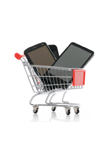 Some of you may still be investigating the option of a smartphone app as a possible commerce channel (m-commerce), unsure of its ability to drive sales. On the other hand, many independent retailers have come to terms that consumers flock to the Internet for product information and purchase, resulting in the launch of B2C sites to keep up with the growing trend of e-commerce and substitute for the decline of in-store sales. But have you overlooked the fact that m-commerce is simply a narrower form of e-commerce? The rise in mobile shopping in fact has added to e-commerce’s portion of the overall retail pie, while taking away from in-store sales.
Some of you may still be investigating the option of a smartphone app as a possible commerce channel (m-commerce), unsure of its ability to drive sales. On the other hand, many independent retailers have come to terms that consumers flock to the Internet for product information and purchase, resulting in the launch of B2C sites to keep up with the growing trend of e-commerce and substitute for the decline of in-store sales. But have you overlooked the fact that m-commerce is simply a narrower form of e-commerce? The rise in mobile shopping in fact has added to e-commerce’s portion of the overall retail pie, while taking away from in-store sales.
PayPal Recognizes m-Commerce’s Role in e-Commerce Success
For those of you operating an e-commerce business along with your brick and mortar store, you may be familiar with PayPal, a partnering e-commerce business allowing payment and money transfers to be made through the Internet. In a recent PayPal consumer report, it was confirmed that there is not only an increasing need to invest in multi-channel retail, but that in-store sales can be expected to fall with e-commerce and associated m-commerce on the rise. Internet Retailer reveals in a recent article that, “PayPal has experienced significant growth in its mobile payment volume, growing from $25 million in 2008 to $750 million in 2010. By 2013, the company is expecting its mobile payments volume to reach $7.5 billion.”
It comes as no surprise that the increasing daily use of smartphone applications (apps) and smartphone browsers has created a channel for your customers to purchase products. As Portio Research Limited’s report, “Mobile Applications Futures 2010-2015” forecasts, “The global mobile applications user base is expected to grow at a compound annual growth rate of 37 percent between 2009 and 2015 to reach nearly 256 million by the end of 2015.” Embracing m-commerce could potentially market you to those 256 million users and consumers.
